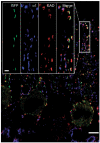From synapse to behavior: rapid modulation of defined neuronal types with engineered GABAA receptors
- PMID: 17572671
- PMCID: PMC2092503
- DOI: 10.1038/nn1927
From synapse to behavior: rapid modulation of defined neuronal types with engineered GABAA receptors
Abstract
In mammals, identifying the contribution of specific neurons or networks to behavior is a key challenge. Here we describe an approach that facilitates this process by enabling the rapid modulation of synaptic inhibition in defined cell populations. Binding of zolpidem, a systemically active allosteric modulator that enhances the function of the GABAA receptor, requires a phenylalanine residue (Phe77) in the gamma2 subunit. Mice in which this residue is changed to isoleucine are insensitive to zolpidem. By Cre recombinase-induced swapping of the gamma2 subunit (that is, exchanging Ile77 for Phe77), zolpidem sensitivity can be restored to GABAA receptors in chosen cell types. We demonstrate the power of this method in the cerebellum, where zolpidem rapidly induces significant motor deficits when Purkinje cells are made uniquely sensitive to its action. This combined molecular and pharmacological technique has demonstrable advantages over targeted cell ablation and will be invaluable for investigating many neuronal circuits.
Figures





References
-
- Riedel G, et al. Reversible neural inactivation reveals hippocampal participation in several memory processes. Nat. Neurosci. 1999;2:898–905. - PubMed
-
- Lomber SG. The advantages and limitations of permanent or reversible deactivation techniques in the assessment of neural function. J. Neurosci. Methods. 1999;86:109–117. - PubMed
-
- Pereira de Vasconcelos A, et al. Reversible inactivation of the dorsal hippocampus by tetrodotoxin or lidocaine: a comparative study on cerebral functional activity and motor coordination in the rat. Neuroscience. 2006;141:1649–1663. - PubMed
-
- Wulff P, Wisden W. Dissecting neural circuitry by combining genetics and pharmacology. Trends Neurosci. 2005;28:44–50. - PubMed
Publication types
MeSH terms
Substances
Grants and funding
LinkOut - more resources
Full Text Sources
Other Literature Sources
Molecular Biology Databases
Research Materials

